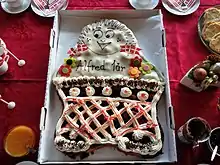Kagemand
Kagemand or Kagekone (English: Cake man or Cake woman) is a Danish cake in the shape of a boy or a girl,[1] which is traditionally eaten at birthdays and anniversaries.[2][1] It is typically a variation of the simpler brunsviger.

Kagekone served at a boy's birthday party
The cake is usually made with either a soft yeast dough topped with brown sugar or a Danish pastry dough topped with icing glacé. In any case, the cake is decorated with candy and festive Danish flags. In some subcultures, the birthday party may start with the cake figure being decapitated or dismembered, while all the guests feign horror at the act.[3][4]
References
- "Happy birthday, Gen Z: celebrating with 16-year-olds around the world". The Guardian. U.K. 10 December 2016. Retrieved 12 December 2016.
- Vendelbjerg, Lars (27 August 2015). "Bager lavede fem meter høj kagemand" [A baker made a 5-metre long kagemand]. Holstebro Struer Dagbladet (in Danish). Holstebro, Denmark. Retrieved 12 December 2016.
- Sandi Toksvig (16 October 2018), "Episode 8 - Danish week", The Great British Bake Off
- Victoria Williams (2016), "Birthday cakes, international", Celebrating Life Customs around the World, ABC-CLIO, vol. Baby Showers to Funerals, p. 35, ISBN 9781440836596
External links
Wikimedia Commons has media related to Kagemand.
- Images of Kagemand from a Danish bakery.
This article is issued from Wikipedia. The text is licensed under Creative Commons - Attribution - Sharealike. Additional terms may apply for the media files.